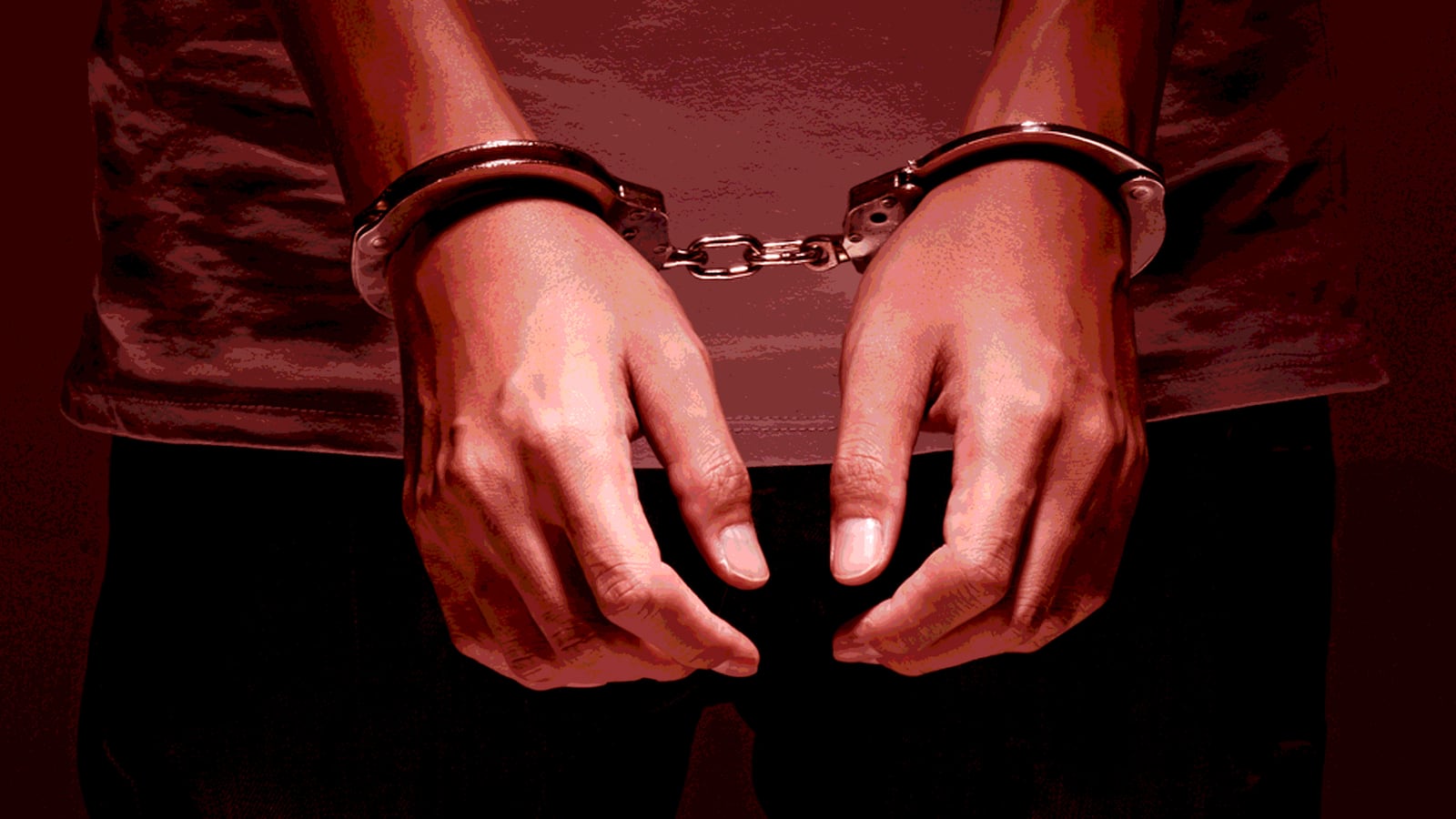When Florencio Banos was brought before an immigration judge at the Varick Street Detention Center in Manhattan, he sat next to an empty chair. It was for his lawyer, if he had one.
The 45-year-old Salvadoran immigrant was finding out the hard way about the differences between the criminal justice system and the immigration court: You don’t necessarily get a lawyer in immigration court, even though you can be sent to jail for years or expelled from the country, far from family.
“I’m just waiting to speak to a Legal Aid Society lawyer because I don’t have money to pay a lawyer,” Banos said in Spanish to Immigration Judge Patricia Buchanan.
Banos’ problem was that the right to free counsel granted to indigent criminal defendants doesn’t apply to deportation cases, which are civil. As he sat before a black-robed judge, the distinction didn’t seem to make much difference, given that Banos was shackled at the wrists and the waist and wearing the same orange jumpsuit that any prisoner would wear.
Without a lawyer, there is slim chance to make use of the various avenues the notoriously complex immigration law offers to fend off deportation or to challenge the possibility of spending months or years of waiting in jail. Studies have shown that an immigration detainee with a lawyer has more than 10 times the chance of prevailing—over 1,000 percent, that is—compared to someone who is unrepresented, like Banos. Those who were never detained have more than triple the chance to prevail with a lawyer.
This inequity started long before the Trump administration, but President Donald Trump’s push to arrest and detain many more undocumented immigrants will likely aggravate it. According to the Transactional Records Access Clearinghouse at Syracuse University, the backlog in immigration courts swelled to 600,000 cases as of May 31, growing 21 percent in a year.
Even for those used to observing the often chaotic process in criminal courts, where public defenders shout out names to find clients in overcrowded courtrooms, the procedures in immigration court are an eye-opener.
“I don’t think everyday Americans would expect such dramatic punishment to be given without the person having a fair chance to make their case,” said Camille Mackler, director of legal initiatives at the New York Immigration Coalition.
Banos received a lawyer free of charge when he faced a domestic violence-related criminal contempt charge on Jan. 22 in the Suffolk County First District Court in Central Islip, New York. He posted $500 cash bail the next day, but, under a policy Suffolk County had revised seven weeks earlier, he was held and turned over on Jan. 24 to U.S. Immigration and Customs Enforcement.
Previously, the sheriff’s office in Suffolk County on Long Island’s East End had refused to hold immigrants unless ICE agents came up with a warrant from an immigration judge. But following a legal opinion from the county attorney in December, the county shifted to holding people up to 48 hours more to give ICE time to pick them up. Whether that was done in response to Trump’s election is a matter of debate in Suffolk County—the sheriff’s office says it’s not so—but in any case, it’s meant that Banos was jailed elsewhere, with no end in sight.
When his hearing in immigration court came up on June 20, he was still locked up, now at the Bergen County Jail in Hackensack, New Jersey.
Judge Buchanan responded to his request for a lawyer by giving him a list of possible choices. But, she explained, “Right now they’re having some real funding difficulties, so I don’t know if they can accept your case.”
“I’ve been in prison five, six months already,” Banos responded through a translator. “And I’m in court now.”
A national study conducted by two professors at UCLA Law School found that a detained immigrant with a lawyer has more than 10 times the chance of winning the case than one who is unrepresented. Just 37 percent of the respondents in immigration courts nationally are represented, the study found. People who are not held in detention have a much better chance to find counsel, but of those detained, like Banos, 86 percent went to court without a lawyer.
Surveying 1.2 million cases decided from 2007 to 2012, UCLA professors Ingrid Eagly and Steven Shafer found that the proportion of detained immigrants who had lawyers in immigration court ran to as little as a “shocking” .002 percent of the 17,053 cases in Tucson, Arizona. Courts located at detention centers in rural areas also had particularly low rates, such as 6 percent of the 41,674 cases decided in Lumpkin, Georgia. Nationally, the study found, just 2 percent of unrepresented immigrants prevailed.
Without representation, “We’ve seen a lot of people agreeing to their deportation,” Eagly said in a phone interview. That’s especially so for those held in jail, often far from relatives and in isolated areas where there are few lawyers practicing immigration law. In Tucson, a “Quick Court” deports people, well, quickly—before they can get a lawyer.
Judge Buchanan’s afternoon calendar call on June 20 in a small courtroom behind locked doors showed the contrast.
One of the detainees with a lawyer, Shuquin Dong, whose young daughter looked on quietly as her mother appeared in court shackled and dressed in orange, was able to overcome the government’s strong objection to releasing her on bond. She had completed a four-month federal sentence for her 2014 conviction over a low-level role in an expansive credit-card fraud, and was arrested by immigration agents at a probation appointment earlier in June. The judge said her decision to grant $20,000 bond instead of holding Dong in detention without bond was a “close call.”
Jose Elias Batista, a 26-year-old man from the Dominican Republic, had lawyers from the Legal Aid Society who were ready to challenge his removal. According to ICE spokeswoman Rachael Yong Yow, he had a conviction for drug possession, and was taken into ICE custody last Nov. 10. She said he is a lawful permanent resident of the United States, which means he holds a “green card” and is authorized to reside permanently and work.
His lawyers said they were ready to challenge his removal, in part over the technical question of whether he had committed what the immigration law defines as an “aggravated felony”—that is, one of the crimes listed as grounds for deportation.
It would take a qualified lawyer to know that what may be considered a felony under state law is not necessarily an “aggravated felony” under the immigration laws. In fact, a federal appeals court decision issued June 21 will give Batista’s lawyers stronger grounds for their argument. It ruled in favor of a 54-year-old immigrant from Grenada and draws the kind of specialized distinctions that lawyers are trained to debate. This is the everyday business of the courts, but one might also say it’s a routine that helps to make America great: equal justice under the law.
Without legal help, the playing field is tilted hard against any immigrant seeking to avoid deportation. Many, like the man who appeared immediately before Banos, just want to get out of the country as quickly as possible so they can get out of jail.
Banos, who federal authorities said has had four misdemeanor convictions, didn’t even have his court file, so the judge gave him a copy. Looking over the papers, she said, “I see you’ve been detained for quite some time.”
Cleanly shaved with a trimmed mustache and short, salt-and-pepper hair, Banos picked up the documents with his one unshackled hand. “My problem is I don’t know how to read,” he told the judge in Spanish. “I don’t know how to write.”
The judge advised Banos that he might be able to seek asylum. Banos seemed to recognize that under the circumstances, it was a long shot. “The only thing I need to know is what are my chances to possibly stay here,” he said.
The judge was noncommittal, but said she was “hopeful” that at Banos’ next hearing on July 5, there might be pro bono lawyers available.
“I do have a question,” Banos said. “Is all of this free?”
New York City began funding legal help for detained immigrants after a jolt from a persuasive 2011 study convened by Robert Katzmann, chief judge of the 2nd U.S. Circuit Court of Appeals in Manhattan (PDF). It found that not only did respondents in New York’s immigration courts lack lawyers—“a surprise to those uninitiated in the field of immigration law”—but that two-thirds of the detainees were sent to facilities in Texas and Louisiana, making it all the more difficult to find legal help. (Federal authorities have since responded to that problem by finding more detention space in the New York area.)
The report noted that a noncitizen arrested for jumping a subway turnstile was provided with a lawyer even though it was unlikely the defendant would spend more than a day in jail. “If, however, the resulting conviction triggers removal proceedings, where that same noncitizen can face months of detention and permanent exile from her family, her home, and her livelihood, she is all too often forced to navigate the labyrinthine world of immigration law on her own, without the aid of counsel,” it said.
At that point, just 3 percent of immigrant detainees won their cases in immigration court. Since New York began funding the New York Immigrant Family Unity Project, a first-of-its-kind program that pays nonprofit groups to represent detained immigrants, in 2013, that share is up tenfold, to 30 percent.
As Banos discovered, there are gaps. A funding shortfall led the project to stop taking new clients in June until, it is hoped, the flow resumes in the city’s new fiscal year on July 1. There is also a dispute between Mayor Bill de Blasio and the City Council about the mayor’s opposition to providing taxpayer-funded lawyers for anyone convicted of one of 170 crimes.
Still, lawyers who represent the poor in New York immigration cases know there is a big difference between what they see and what goes on in parts of the country where few respondents are represented.
“There are courts where there’s no one there” to represent immigrants the government wants to deport, said Andrea Sáenz, supervising attorney of the immigration unit at the Brooklyn Defenders Service. “There are no nonprofits, there’s no private bar. And how many people there actually have strong claims to relief? It’s very sad.”
***
Immigrants who face deportation but are not being held in detention are much more free to find legal help. In New York, the city funding doesn’t apply to these cases, though, so it’s still far from a sure thing.
But at least they can go to an advice center open twice a week in a courtroom on the 12th floor of 26 Federal Plaza in lower Manhattan, where their cases are heard.
Kristi Dalling, an attorney with Catholic Charities, was running the center on a recent morning, working with law students to advise a stream of people, most of them from Central America.
New York has a good concentration of nonprofit legal and advocacy groups that try to fill the gap, as well as many private lawyers willing to pitch in pro bono. But still, Dalling said, there are people facing deportation—and often the breakup of their family—without a lawyer. Those who come from the suburban and rural areas outside the city are less likely to find a pro-bono lawyer, she said.
“There really still is a dire need for representation, now more than ever,” Dalling said. “We hear of more people getting arrested… We see so many people everyday who don’t have representation.”





